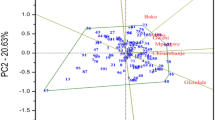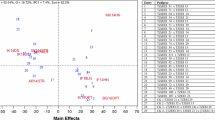Abstract
Quality Protein Maize (QPM) varieties are rich in lysine and tryptophan, but suffer reduced grain yield (GY) in West and Central Africa (WCA) due to low soil nitrogen (low-N) and intermittent drought stress (DS). Development of stress-tolerant QPM hybrids will enhance sustainable maize production and improve nutritional health in WCA. Knowledge of combining ability, gene action and heterotic grouping of QPM inbred lines are crucial to successful breeding strategies for the development of superior hybrids with enhanced nutritional values. The objectives of this study were to: (i) determine the combining ability for GY and yield-related traits among 13 newly developed QPM inbred lines, and (ii) assign the QPM inbred lines to distinct heterotic groups based on general combining ability effects of multiple traits under low-N and DS conditions. Seventy-eight single cross hybrids were generated through half-diallel mating of 13 QPM inbred lines and evaluated along with three commercial checks for GY and yield-related traits under the low-N and DS conditions. Significant general combining ability (GCA) and specific combining ability effects were obtained for GY and yield-related traits. Both additive and non-additive gene effects were involved in the inheritance of GY and other traits under low-N and DS conditions. However, the additive gene effect for GY was twice as large as non-additive gene effect. Three heterotic groups were each delineated under low-N and DS. Inbred lines, CRIZEQ-44 and CRIZEQ-77 belonging to different heterotic groups were identified as testers for the development of superior hybrids for low-N and DS environments.




Similar content being viewed by others
Abbreviations
- ASI:
-
Anthesis-silking interval
- BI:
-
Base index
- DAS:
-
Days after sowing
- AD:
-
Days to 50% flowering
- SD:
-
Days to 50% silking
- DS:
-
Drought stress
- EA:
-
Ear aspect
- EHT:
-
Ear height
- GCA:
-
General combining ability
- GY:
-
Grain yield
- HGCAMT:
-
Heterotic grouping based on GCA of multiple traits
- High-N:
-
High soil nitrogen
- Low-N:
-
Low soil nitrogen
- MC:
-
Moisture content
- EPP:
-
Number of ears per plant
- PA:
-
Plant aspect
- PHT:
-
Plant height
- QPM:
-
Quality protein maize
- SCA:
-
Specific combining ability
- SG:
-
Stay-green characteristics
- WW:
-
Well-watered
References
Abe A, Adetimirin VO, Menkir A, Moose SP, Olaniyan AB (2013) Performance of tropical maize hybrids under conditions of low and optimum levels of nitrogen fertilizer application–grain yield, biomass production and nitrogen accumulation. Maydica 58(2):141–150
Abu P, Badu-Apraku B, Ifie BE, Tongoona P, Ribeiro PF, Obeng- Bio E, Offei SK (2021) Genetics of extra- early- maturing yellow and orange quality protein maize inbreds and derived hybrids under low soil nitrogen and Striga infestation. Crop Sci 61(2):1052–1072. https://doi.org/10.1002/csc2.20384
Annor B, Badu-Apraku B (2016) Gene action controlling grain yield and other agronomic traits of extra-early quality protein maize under stress and non-stress conditions. Euphytica 212(2):213–228
Badu-Apraku B, Akinwale RO, Ajala SO, Menkir A, Fakorede MAB, Oyekunle M (2011) Relationships among traits of tropical early maize cultivars in contrasting environments. Agron J 103(3):717–729
Baker RJ (1978) Issues in diallel analysis. Crop Sci 18(4):533–536. https://doi.org/10.2135/cropsci1978.0011183X001800040001x
Bänziger M, Setimela PS, Hodson D, Vivek B (2006) Breeding for improved abiotic stress tolerance in maize adapted to southern Africa. Agric Water Manag 80(1–3):212–224
Bellon MR (2001) Participatory methods in the development and dissemination of new maize technologies, pp. 4–20. In: CIMMYT 1999–2000 world maize facts and trends. Meeting world maize needs: technological opportunities and priorities for the public sector. Pingali, PL ed. CIMMYT, Mexico
Betrán FJ, Beck D, Bänziger M, Edmeades GO (2003) Genetic analysis of inbred and hybrid grain yield under stress and nonstress environments in tropical maize. Crop Sci 43(3):807–817. https://doi.org/10.2135/cropsci2003.8070
Bhadmus OA, Badu-Apraku B, Adeyemo OA, Ogunkanmi AL (2021) genetic analysis of early white quality protein maize inbreds and derived hybrids under low-nitrogen and combined drought and heat stress environments. Plants 10(12):25–36. https://doi.org/10.3390/plants10122596
Bhatnagar S, Betrán FJ, Rooney LW (2004) Combining abilities of quality protein maize inbreds. Crop Sci 44(6):1997–2005. https://doi.org/10.2135/cropsci2004.1997
Dhillon BS, Pollmer WJ (1978) Combining ability analysis of an experiment conducted in two contrasting environments. EDV Med Biol 9(3/4):109–111
Dosho B, Ifie BE, Asante IK, Danquah EY, Zeleke H (2021) Combining ability of quality protein maize inbred lines under low and optimum soil nitrogen environments in Ethiopia. Afr J Plant Sci 15(8):237–249
Fan XM, Tan J, Yang JY, Chen HM (2004) Combining ability and heterotic grouping of ten temperate, subtropical and tropical quality protein maize inbreds. Maydica 49(4):267–272
FAOSTAT (2020) http://www.fao.org/faostat/en/#data. Accessed 18 December 2021.
Griffing B (1956) Concept of general and specific combining ability in relation to diallel crossing systems. Aust J Biol Sci 9(4):463–493. https://doi.org/10.1071/BI9560463
Hallauer AR, Carena MJ, Miranda-Filho JD (2010) Quantitative genetics in maize breeding (Vol. 6). Springer Sci Business Media. https://doi.org/10.1007/978-1-4419-0766-0_8
Institute SAS (2017) SAS User’s guide: statistics; version 9.4. SAS Institute Inc., Cary, NC, USA
Kim SK, Adetimirin VO (1997) Responses of tolerant and susceptible maize varieties to timing and rate of nitrogen under Striga hermonthica infestation. Agron J 89(1):38–44
Krivanek AF, De Groote H, Gunaratna NS, Diallo AO, Friesen DK (2007) Breeding and disseminating quality protein maize (QPM) for Africa. Afr J Biotech 6(4):312–324
Landon JR (2014) Booker tropical soil manual: a handbook for soil survey and agricultural land evaluation in the tropics and subtropics. Routledge
Machida L, Derera J, Tongoona P, MacRobert J (2010) Combining ability and reciprocal cross effects of elite quality protein maize inbred lines in subtropical environments. Crop Sci 50(5):1708–1717
Martin RV, Washington R, Downing TE (2000) Seasonal maize forecasting for South Africa and Zimbabwe derived from an agro-climatological model. J Appl Meteorol 39(9):1473–1479
Meseka SK, Menkir A, Ibrahim AES, Ajala SO (2006) Genetic analysis of the performance of maize inbred lines selected for tolerance to drought under low nitrogen. Maydica 51(3):487–495
Musila RN, Diallo AO, Makumbi D, Njoroge K (2010) Combining ability of early-maturing quality protein maize inbred lines adapted to Eastern Africa. Field Crops Res 119(2–3):231–237. https://doi.org/10.1016/j.fcr.2010.07.009
NeSmith DS, Ritchie JT (1992) Effects of soil water-deficits during tassel emergence on development and yield component of maize (Zea mays L.). Field Crops Res 28(3):251–256
Njeri SG, Makumbi D, Warburton ML, Jumbo MB, Cheminingwa G (2017) Genetic analysis of tropical quality protein maize (Zea mays L.) germplasm. Euphytica 213(11):1–19. https://doi.org/10.1007/s10681-017-2048-4
Obeng-Bio E, Badu-Apraku B, Ifie BE, Danquah A, Blay ET, Annor B (2019) Genetic analysis of grain yield and agronomic traits of early provitamin a quality protein maize inbred lines in contrasting environments. J Agric Sci 157(5):413–433
Ofori AP, Ofori K, Obeng-Antwi K, Tengan KML, Badu-Apraku B (2015) Combining ability and heterosis estimate of extra-early quality protein maize (QPM) single cross hybrids. J Plant Breed Crop Sci 7(4):87–93
Owusu GA, Ribeiro PF, Abe A (2021) Genetic analysis of grain yield and agronomic traits of quality protein maize inbred lines and their single-cross hybrids under drought stress and well-watered conditions. Ecol Genet Genom 22:100–105. https://doi.org/10.1016/j.egg.2021.100105
Oyekale SA, Badu-Apraku B, Adetimirin VO (2020) Combining ability of extra-early biofortified maize inbreds under Striga infestation and low soil nitrogen. Crop Sci 60(4):19–25. https://doi.org/10.1002/csc2.20195
Page AL, Miller RH, Keeney DR, Baker DE, Ellis R, Rhoades JD (1982) Methods of Soil Analysis. eds (No. 631.41 MET 9–2 1982. CIMMYT.)
Prasanna BM, Vasal SK, Kassahun B, Singh NN (2001) Quality protein maize. Current Sci 81:1308–1319
Pswarayi A, Vivek BS (2008) Combining ability amongst CIMMYT’s early maturing maize (Zea mays L.) germplasm under stress and non-stress conditions and identification of testers. Euphytica 162(3):353–362
Snedecor GW, Cochran WG (1989) Statistical methods, 8th edn. Iowa State University Press, Ames, IA, USA
Terron A, Preciado E, Córdova H, López R (1997) Determinación del patrónheterótico de 30 líneas de maízderivadas de la población 43SR del CIMMYT. Agronomía Mesoamericana. https://doi.org/10.15517/am.v8i1.24720
Twumasi-Afriyie S, Palacios Rojas N, Friesen D, Teklewold A, Gissa DW, De Groote H, Prasanna BM (2016) Guidelines for the quality control of Quality Protein Maize (QPM) seed and grain. Addis Ababa, Ethiopia
Wang Y, Zhang X, Chen J, Chen A, Wang L, Guo X, Niu Y, Liu S, Mi G, Gao Q (2019) Reducing basal nitrogen rate to improve maize seedling growth, water and nitrogen use efficiencies under drought stress by optimizing root morphology and distribution. Agric Water Manag 212:328–337
Wegary D, Vivek BS, Labuschagne MT (2014) Combining ability of certain agronomic traits in quality protein maize under stress and non-stress environments in Eastern and Southern Africa. Crop Sci 54(3):1004–1014. https://doi.org/10.2135/cropsci2013.09.0585
Zhang Y, Kang MS, Lamkey KR (2005) DIALLEL-SAS05: a comprehensive program for Griffing’s and Gardner-Eberhart analyses. Agron J 97(4):1097–1106
Acknowledgements
The authors express their profound gratitude to CSIR-Crop Research Institute, Maize Improvement Programme, Fumesua-Kumasi, for providing genetic materials and institutional support throughout the implementation of the project. We also want to thank Dr. C. Nelimor, Miss J. Adu-Mensah, Dr. T. Chagomoka, Mrs. F. Siaw, Miss P. Owusu-Mensah, Mr. K. Asamoah, Dr. A. Oppong, Dr. D. Nyadanu, and Mr. K.A. Manigben for their important roles in this study.
Funding
This research work was part of the Ph.D. research work of the first author, supported by the African Union Commission through the Pan-African Institute of Life and Earth Sciences (Including Health and Agriculture) of the Pan-African University (PAU), University of Ibadan, Nigeria.
Author information
Authors and Affiliations
Corresponding authors
Ethics declarations
Conflict of interest
The study was undertaken without any private or commercial financial engagements that could be declared a conflict of interest.
Additional information
Publisher's Note
Springer Nature remains neutral with regard to jurisdictional claims in published maps and institutional affiliations.
Rights and permissions
Springer Nature or its licensor (e.g. a society or other partner) holds exclusive rights to this article under a publishing agreement with the author(s) or other rightsholder(s); author self-archiving of the accepted manuscript version of this article is solely governed by the terms of such publishing agreement and applicable law.
About this article
Cite this article
Owusu, G.A., Abe, A. & Ribeiro, P.F. Genetic analysis and heterotic grouping of quality protein maize (Zea mays L.) inbred lines and derived hybrids under conditions of low soil nitrogen and drought stress. Euphytica 219, 29 (2023). https://doi.org/10.1007/s10681-023-03159-4
Received:
Accepted:
Published:
DOI: https://doi.org/10.1007/s10681-023-03159-4




